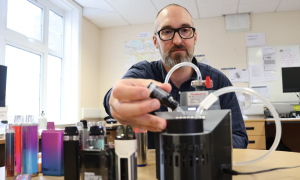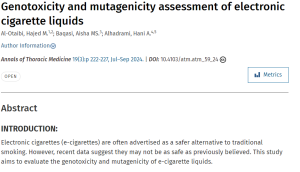DOI: https://doi.org/10.1016/j.cjca.2023.04.020
ABSTRACT
This review provides an overview of potential vaping cessation interventions in adult former smokers. The interventions reviewed are varenicline, bupropion, nicotine replacement therapies (NRT), and behavioral therapy. Evidence for intervention effectiveness is provided when available, such as for varenicline, whereas recommendations for bupropion and NRT are extrapolated from case studies or smoking cessation guidelines. The limitations of these interventions, a general lack of prospective studies, and a discussion of challenges to vaping safety from a public health perspective are also discussed. Although these interventions show promise, further research is needed to establish precise protocols and dosages in the context of vaping cessation, rather than adapting existing recommendations from smoking cessation.
Introduction
Many adult smokers have successfully achieved smoking cessation via e-cigarettes or other vaping devices but now face vaping addiction. After years of vaping, these former smokers seek vaping cessation without resuming their smoking habits. Although this situation is prevalent and acknowledged to be a public health concern, existing reviews and clinical studies have not identified many prospective studies on this issue. Evidence-based clinical guidelines are lacking regarding vaping cessation interventions in adults, compared to smoking cessation guidelines in smokers. This review presents possible vaping cessation interventions available to former smokers who use e-cigarettes as a method of smoking cessation.
Methods
To capture vaping cessation guidelines associated with former ex-smokers, a search was performed on the databases PubMed, Google Scholar, and Ovid (Embase) in August 2022. MESH terms were used when relevant for the following keywords: vaping, cannabis, marijuana smoking, ex-smokers, adult, guideline, cardiovascular/heart disease risk factors, and respiratory risk factors. To identify clinical studies related to vaping health or vaping cessation guidelines in adults, several searches were performed on clinicaltrials.gov in August 2022 with the condition of vaping and keywords for cannabis, adult, guidelines, vaping cessation, smoking cessation, former smoker, and ex-smoker. Relevant search results were identified through abstract and title screening or snowballing references of included articles.
Safety concerns with vaping
Vaping via e-cigarettes (ECs) and other electronic nicotine delivery systems (ENDS) remain a popular alternative for smokers wishing to achieve smoking cessation.(1) However, ECs remain to be approved by the FDA for its use in the context of smoking cessation. The Canadian Agency for Drugs and Technologies in Health (CADTH) published a rapid review in 2021 with best practises in using pharmacological interventions for vaping cessation, with the acknowledgement that no evidence-based guidelines currently exist for this situation (2).
Vaping presents additional public health concerns for new vapers and former smokers alike. Although exposure to toxic substances from ECs is substantially lower compared to conventional cigarettes, prolonged vaping use may lead to potential health risks in respiratory and cardiovascular systems. Frequently cited concerns include evidence of disordered respiratory function, altered hemodynamics, endothelial dysfunction, vascular reactivity, and enhanced thrombogenesis.(3) The increased risk of chronic cough, phlegm, bronchitis, asthma, and airway injuries may also lead to inflammatory conditions like pneumonia or interstitial lung disease. (4,5)
Prolonged vaping in ex-smokers may also lead to nicotine dependence disorder. According to the Diagnostic and Statistical Manual of Mental Disorders (DSM-5) criteria(6), nicotine dependence occurs when the use of nicotine products over one year has resulted in at least two of the following features: (1) Larger quantities of tobacco over a longer period than intended are consumed; (2) Tolerance for nicotine; and (3) Withdrawal symptoms upon cessation of use. ECs may be supplanting conventional cigarettes, leading to continued nicotine dependence and addictive smoking behaviors. (7) Thus, there is a timely need to introduce interventions to help former smokers achieve vaping cessation.
Varenicline
Varenicline is a partial nicotine cholinergic receptor agonist, demonstrated to be highly effective in smoking cessation, as it reduces craving and withdrawal symptoms.(8) It is well studied and approved for use in smoking cessation and nicotine use disorder for adults and youth over the age of 17, with a prescribed 12-week regimen of 0.5 mg/day for 3 days, then 0.5 mg 2x/day for 3 days, then 1 mg 2x/day for the rest of the period.(8) After 12 weeks, the healthcare practitioner may extend its use depending on the risk of relapse, as many long-term nicotine users require a longer duration of treatment. Although varenicline is amongst the most widely prescribed pharmacotherapies in these contexts, there are no established guidelines for its use in vaping cessation. (9)
A 2019 UK cohort study with 204 dual smoking and vaping participants utilized questionnaires, phone calls, and saliva kits at baseline, 3 and 6 months to assess e-cigarette cessation in dual users. (10)
Compared to non-varenicline users, varenicline users had higher chances of successful abstinence from smoking (17.5% vs 4.8%, p=0.006, RR=3.6, CI:1.4 to 9.0), vaping (12.5% vs 1.6%, p=0.007, RR=7.8, CI:1.7 to 34.5), both smoking and vaping (8.8% vs 0.8%, p=0.02, RR=10.9, CI:1.4 to 86.6) for at least 3 months during the 6-month follow-up period. (10) The 80 varenicline users (28.7% women, 33.6 mean age; 11.6 SD) also reported less enjoyment in vaping during the study period (p=0.04) with notable reductions in nicotine intake than 124 non-users (30.6% women, 30.4 mean age; 11.2 SD) at 3 months (p<0.001) and 6 months (p<0.001).(10) These results indicate that varenicline confers a highly effective and significant improvement in vaping cessation when compared to placebo.
This study is complimented by a 2019 case report, which describes a 53-year-old Caucasian man with 15 years of history of tobacco use and a desire to quit vaping after using e-cigarettes as a smoking cessation aid for the past 4 years. (9) Four months after using varenicline at a dosage of 1-2 mg/day with some behavioral techniques to aid in vaping cessation, the patient reported sustained vaping cessation since the beginning with no adverse effects (e.g. nausea, headache, and vivid dreams). (9) The patient reported that barriers to achieving vaping cessation include the severity of nicotine addiction and vaping triggers.
Existing clinical studies suggest that varenicline is more effective in sustaining abstinence than placebo or other pharmacotherapies used in smoking cessation (i.e. bupropion or nicotine replacement therapies). (11, 12, 13)
The EAGLES study, a trial with over 8000 participants, indicated that varenicline performed better than nicotine patches, bupropion, or placebo for smoking cessation. (14) Although data for the vaping context is limited, the results may be comparable and thus potentially extrapolated for this situation. As varenicline is administered orally with minimal adverse effects, it may be a convenient and effective method for those who are unable to quit vaping with other methods. (15)
Bupropion
Bupropion is an antidepressant of the norepinephrine-dopamine disinhibitor (NDDI) class, which inhibits the neuronal uptake of norepinephrine, serotonin, and dopamine. (16) It is currently approved for the treatment of depression, smoking cessation, and nicotine use disorder, although its mechanism of action is incompletely understood. (16,17) Although it is efficacious in smoking cessation, currently there are no identified clinical studies or case reports providing guidelines for the use of bupropion in vaping cessation contexts. It is typically prescribed as one 150-mg tablet per day for 3 days, increasing the dose to 300 mg per day (given as one 150-mg tablet twice each day with an interval of at least 8 hours between each dose), not exceeding 300 mg per day. (18,19) Bupropion is usually given for a minimum of 12 weeks, with continued use if needed to support ongoing cessation. (18,19)
Common side effects include insomnia, headache, dry mouth, nausea, and anxiety, coinciding with nicotine withdrawal symptoms which may also occur during treatment. (19,20) Bupropion lowers the seizure threshold and is thus contraindicated in those with epilepsy or recent head trauma, however, seizure events were very uncommon in clinical studies. It has been rarely associated with serotonin syndrome, especially if used with other serotonergic drugs, such as methadone or escitalopram. In otherwise safe contexts, efficacy studies indicate that bupropion may be more effective than placebo in achieving smoking cessation for short to medium durations (for 6-18 months), with long-term efficacy currently unclear. (19,21) Bupropion may be prescribed off-label to youth under 18 years old. (17)
Nicotine Replacement Therapy (NRT)
NRTs are full agonists that bind to nicotinic cholinergic receptors. (17) They provide a temporary replacement for nicotine and are available as long-acting transdermal patches, or short-acting agents such as gum and sublingual tablets or lozenges. (8) There is currently a lack of guidance or trials on the safety and efficacy of NRT use in stopping vaping addiction, including variability in establishing the equivalent dosage and form of NRT to recommend.(22) Like the other pharmacotherapies mentioned, there are no clinical studies establishing a clear NRT regimen for vaping cessation. Most guidelines on NRT use and dosage are in the context of smoking, rather than vaping cessation.
One case study of a 24-year-old Caucasian male with moderate nicotine dependence (Fagerström scale: 7) enrolled in a tobacco treatment program successfully reported vaping cessation through NRT use.(23) He began daily use of a 14 mg patch with 4 mg lozenges (8x/day) and behavioral therapy. After continued use of the 4 mg lozenge or gum (8x/day), the patient stopped vaping after the third week and persisted throughout the 12-week program. NRTs were used intermittently following this, until it was discontinued at the 6-month mark, with the patient remaining e-cigarette, tobacco, and nicotine free for one-year post-check-up.
As reported in this case study, the various flavorings in NRTs can seemingly impact their effectiveness in curbing nicotine addiction or the ability of the user to sustain proper use. (23) In addition, the medium of nicotine delivery between NRTs widely varies, and there is a possibility that NRTs that mimic vaping behavior may sustain rather than mitigate addictive vaping habits. Recent advances in NRT devices also include inhalers and nicotine vaccines which mitigate nicotine dependence with minimal adverse effects. (24) Pharmaceutical NRTs are designed to offer a safer and more effective delivery of nicotine than consumer vaping products, in the hopes of allowing the user to gradually wean off nicotine dependency and reduce withdrawal symptoms. (25)
NRT is currently only FDA-approved for smoking cessation.(26) To our knowledge, there are no studies on the use of NRT for vaping, and as such, guidelines can only be extrapolated from conventional cigarettes. For example, one cigarette contains roughly 1-2 mg of nicotine, with one pack of 25 cigarettes containing 25-50 mg of nicotine per day. (8) The patch is available in 7 mg, 14 mg, and 21 mg dosages, and may supplement an equivalent nicotine dose of 14-21 mg/day, with gradual tapering to 7 mg/day of nicotine.(27) The lozenge and gum provide 2-4 mg of nicotine, with 1 piece every 1-2 hours as needed (at least 4-5 pieces/day). Notably, the dosage of nicotine absorbed in the body from the oral intake is also only about half of the prescribed amount. (8)
Behavioural Therapy
A wide variety of behavioural therapies exist, although most studies are tailored for youth or smoking cessation, with few studies of therapy in the adult former smoker context. (28, 29, 30, 31) Types of behavioural therapies can range from one-to-one therapy, brief advice, self-help materials, group counselling, telehealth checkups, or social media-based interventions.(28,32,33) A 2020 case report with a 23-year old male previous smoker suggests that tapering of vaping, reducing nicotine concentration, and restricting vaping times, coupled with behavioral counseling for 12 weeks was successful at achieving vaping cessation at a 6-month follow-up.(34) Prior to this, the patient had 6 years of smoking history mixed with cannabis and alcohol use, evaluated as high dependence on the Fagerstrom Test for Nicotine Dependence (FTND), and unsuccessfully attempted to quit nicotine products 6 times. The effectiveness of behavioural therapy depends on many factors such as the frequency of follow-up and expertise of the healthcare professional. Although there are no studies in vapers, a 2017 systematic review of 49 trials with over 19,000 participants revealed that one-to-one behavioural therapy was more effective in achieving smoking cessation than a minimal contact control arm such as brief advice or self‐help materials (RR 1.57, 95% CI 1.40 to 1.77, I2 = 50%). (35) The results can potentially be extrapolated to vaping cessation.
Studies have shown that behavioural therapy in combination with most pharmacotherapy agents result in higher abstinence rates for smoking cessation than pharmacotherapy alone.(15,36) A similar approach may be adopted for vaping cessation. As we have seen, the case report demonstrated that tapering of vaping, reducing nicotine concentration and restricting vaping times, in combination with behavioral counseling can be effective for vaping cessation.(34) In lieu of explicit guidelines or approved pharmacotherapies for vaping cessation, a suggested recommendation for achieving vaping cessation is the use of behavioural therapy for mitigating addictive vaping behaviours and triggers in combination with pharmacotherapy for treating nicotine addiction.
Barriers to Vaping Cessation in Socioeconomically Disadvantaged Populations
The majority of adults who smoke or use electronic cigarettes fall within potentially marginalized groups. These groups include racialized minorities, those with low socioeconomic status or low levels of education, and those with behavioral health conditions like drug addiction or mental illness. Evidence suggests that these populations may have more difficulty quitting even after attending behavioural therapy-based cessation programs. (32) A potential reason is the barrier to accessing affordable prescriptions or counselling for treating nicotine addiction. (32) Fear of legal prosecution may also prevent these populations from disclosing cannabis use and behavioural issues to their healthcare practitioners (37). Although public programs and referrals to harm reduction resources are advertised, access to effective vaping cessation interventions remain a pressing challenge for socioeconomically disadvantaged populations.
Future Directions
Few guidelines address vaping cessation in adult former smokers. Similarly, there is a scarcity of clinical studies which address this issue. A survey of clinicaltrials.gov revealed only one ongoing pharmacotherapy-based clinical trial assessing the feasibility of varenicline and brief behavioural therapy for vaping cessation (VAPEscape) in 20 adults 18-65 years old for 12 weeks, with an estimated study completion date of December 2024.(38) In this study, vaping participants will be treated with a 12 week course of varenicline with nicotine dependence counselling via a certified tobacco treatment specialist, followed up for 12 weeks after the medication is administered.(38) The regimen is developed based on standard guidelines for treating tobacco dependence (e.g. varenicline dosage of 0.5 mg once daily for 3 days, then 0.5 mg twice daily for days 4-7, then 1 mg twice daily for the remaining 11 weeks).(38) Other trials are exploring financial and/or social incentives as a means to encourage vaping cessation, albeit with no results available at the moment.(39) Although vaping addiction is an important public health concern, the majority of available literature on vaping cessation interventions are framed in the context of youth and adolescents.(40,41)
Considerations for Future Guidelines
We compiled vaping cessation recommendations extrapolated from smoking cessation or nicotine use disorder protocols (see Table 1).(41) However, vaping cessation should not be reduced to one or the other, rather, it should be seen as treating a combination of habitual smoking behaviours and nicotine addiction. Thus, there is a pressing need to establish guidelines for the often-overlooked population of adult vapers. Vaping cessation interventions should not only determine the efficacy of various interventions, but also evaluate potential barriers to nicotine dependence in adults commonly cited from case reports. This includes: social pressure, stress reduction, sensory/behavioural gratification, industry marketing, gender or race-based behavioural differences.(41) As vaping addiction is a complex behaviour with biological and social factors, more research is needed to untangle all the mechanisms to inform the best avenues of intervention to succeed at cessation.(40)
Table 1: Summary of Recommendations for Vaping Cessation
Conclusion
Vaping addiction in adult ex-smokers continues to be a major and important public health issue. Without a clear guidance from regulatory bodies and health organizations, clinicians must anecdotally adapt smoking cessation interventions for use in vaping cessation. The current interventions of varenicline, nicotine replacement therapies, bupropion, and behavioural therapies show promise based on evidence and guidelines adapted from smoking cessation. One study using varenicline was shown to be effective in vaping cessation, while the effectiveness of other pharmacotherapies is extrapolated from smoking cessation guidelines and case reports. Further research is needed to establish precise protocols and dosages in the specific context of vaping cessation. Prospective clinical studies are needed to evaluate the effectiveness of these interventions in adults.
Source:
Huerne, K., & Eisenberg, M. J. (2023). Vaping Cessation Interventions in Former Smokers: A Review. Canadian Journal of Cardiology.










